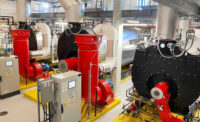Located in Frankfort, Kentucky, Buffalo Trace Distillery is internationally recognized for its bourbon whiskey. The distillery was established at the point where America’s early settlers followed the buffalo migration route across the Kentucky River. Buffalo Trace is among the nation’s oldest continuously operated distilleries, as it was permitted to remain active during Prohibition to make whiskey for medicinal purposes.
Situated on more than 400 acres, the distillery features three centuries of architecture — all of which are still fully functional. Buffalo Trace has been making its award-winning bourbon on-site for more than 200 years.
The company’s bourbon sales have been increasing over the last several years. In 2013, management determined its current inventory was not going to keep pace with the projected demand and that Buffalo Trace needed to plan for the future.
The company has budgeted $1.2 billion for improvements and expansion during the next decade. In fact, the plan is to build three new storage warehouses annually for the next few years. Each warehouse holds nearly 60,000 barrels, so, in order to fill them, Buffalo Trace must increase its bourbon production as well. This is where Cleaver-Brooks becomes part of the story, as the distillery is in the process of upgrading its boilers.
Buffalo Trace management reached out to Cincinnati-based Stoermer-Anderson Inc. (SAI) and requested a quote to replace a coal-fired boiler that had been decommissioned about 15 years prior. The distillery previously worked with SAI on a few projects and was requesting a turnkey bid on the boiler replacement.
SAI enlisted the assistance of Rocky Bahramzad, vice president of international sales, Cleaver-Brooks, to provide his expertise as well. SAI then partnered with Thermal Tech Engineering, which took the lead and did an exemplary job of executing this turnkey project.
“After multiple meetings with Buffalo Trace representatives, the Thermal Tech/Stoermer-Anderson team submitted a bid for the project,” said Tom Schmidt, SAI boiler sales and service manager. “We won the bid because of our turnkey team strategy to get the new boiler inside the historical building with the least amount of disruption.”
Buffalo Trace conducts multiple tours daily around its facility and wanted to ensure visitors would be minimally affected by the installation process. Also, because the distillery is a National Historic Landmark, the boiler had to be installed without compromising the original structure. In order to maintain the integrity of the building, a large window was removed so that the new boiler could be brought inside the boiler house.
Cleaver-Brooks engineers designed a custom D-style industrial watertube boiler with integrated NATCOM burner and Hawk 6000 control system for the project. The burner is designed to fire natural gas as its primary fuel and includes the necessary provisions to add fuel oil firing in the future, if required by the distillery. In order to meet the needs of the facility, the boiler was designed to provide saturated steam at 150 psig with a steam capacity of 150,000 lbs./hr. In addition to the space constraints of moving the boiler into the building, the team worked with Buffalo Trace to locate the forced draft fan and economizer above the boiler on a mezzanine. This arrangement provided a better overall fit for the equipment in the historical building.
Cleaver-Brooks was required to build the boiler on an accelerated schedule. The schedule was based on having the boiler installed and connected into the existing plant systems during an eight-week shutdown planned from late June to late August 2018. Based on the purchase order receipt date, a shipment lead time of only 27 weeks was allowed. Cleaver-Brooks met this commitment and shipped the boiler in 26 weeks from order receipt, enabling time for installation and tie-ins to the facility.
Once the boiler was unloaded on-site, it was transported about a half-mile through the grounds via a Goldhofer hydraulic platform trailer. With the help of some very talented riggers, the boiler was brought in through the window opening via a specialized gantry and lowered to its support structure with no damage to the historical landmark. The new D-style boiler had been custom-designed to fit through the window and cleared the opening with only 1 ½ inches on each side. This creative approach allowed Buffalo Trace to continue with visitor tours during installation.
Boiler startup was completed successfully, and Buffalo Trace is positioned to meet its increasing steam demands. The control system upgrade is expected to provide a substantial fuel savings for the distillery. Another significant improvement is the change from uncontrolled emissions of a coal-fired boiler to the IWT boiler with controlled emissions at 30 ppm NOX.







